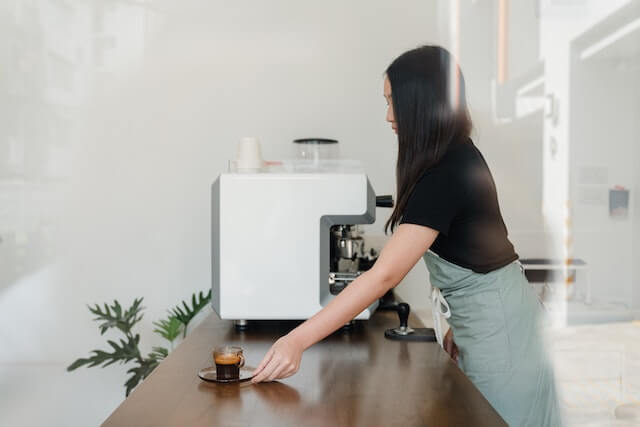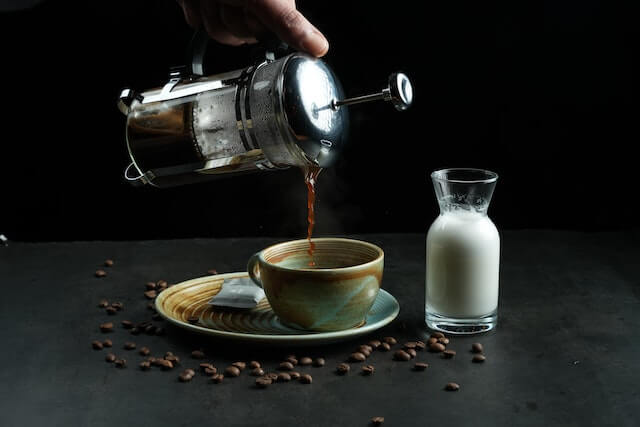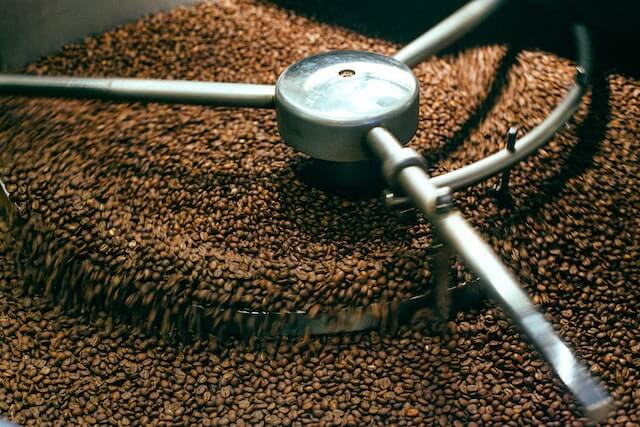For all coffee lovers, espresso should be on top of your list when it comes to trying out different coffee types. If you love a good cup of coffee, you know that espresso is a staple in any coffee shop. Espresso is a classic coffee beverage that has been around for a long time. It is known for its strong taste and its unique brewing. In this blog post, we will take a look at what espresso is, the different types of espresso based drinks, and why you should try it today.
What is Espresso?

Espresso is a concentrated coffee that is created by forcing hot water through finely-ground coffee beans. The brew is made using an espresso machine. A standard espresso shot can be made with about 7 grams of coffee beans that are packed into a portafilter. The machine applies high pressure ranging from nine to ten bars to the coffee grounds in the portafilter. The brewing process takes just 20-30 seconds, and the result is a thick, creamy, and concentrated drink. Espresso is best served in small cups, and it has a strong taste, aroma and acidity.
Types of Espresso Drinks
There are several types of those drinks, and they are always changing depending on new creativity from baristas. Here are some of the most popular drinks:
1. Espresso shot – This is a straight shot of espresso that is served in a small cup. It is the foundation for most other espresso-based drinks.
2. Cappuccino – This is made up of a shot of espresso, steamed milk, and a layer of foam on top.
3. Americano – This is made up of a shot of espresso and hot water, which gives it a similar appearance to drip coffee.
4. Latte – This is made up of a shot of espresso, steamed milk, and a small layer of foam.
5. Macchiato – This is made up of a shot of espresso with a small dollop of foam on top.
Why You Should Try Espresso?
1. Stronger caffeine kick – Espresso has more caffeine than a regular cup of coffee. One ounce of espresso contains about 63 milligrams of caffeine, compared to 12 to 16 milligrams in an ounce of brewed coffee.
2. Taste – Espresso has an intense flavor profile that is a result of its unique brewing. It is rich and creamy and has a strong, bold taste.
3. Variety of Drinks – Espresso is the foundation for many drinks, and you can explore different variations of flavor and taste. You can always find the perfect cup of espresso that suits your taste buds.
4. Convenience – Espresso is easy to make at home, and you can invest in a budget-friendly espresso machine to make your espresso drinks.
What is Non Espresso Coffee drink ?

Coffee is an essential part of many people’s daily routines, especially for those who need a caffeine boost to start their day. While many coffee lovers enjoy espresso and coffee beverages based on espresso, such as cappuccinos or lattes, other coffee options don’t require an espresso machine. Non-espresso coffee is an excellent alternative for those who don’t have an espresso machine or prefer a milder coffee taste.
Non-espresso coffee refers to any coffee that’s not brewed using an espresso machine. These types of coffee are usually brewed using a French press, drip coffee maker, or pour-over coffee maker, among others. One of the most commonly used non-espresso coffee brewing methods is drip coffee. In the drip coffee method, water is dripped through finely-ground beans, creating a rich and flavorful coffee. The resulting coffee flavor is mild and well-rounded compared to the strong and concentrated taste of espresso coffee.
Another popular non-espresso brewing method is the French Press. This method also known as a press pot, is a coffee-making device that looks like a pitcher with a plunger and a mesh filter. To make coffee with the French Press, coarsely ground coffee beans are steeped in hot water. The coffee grounds float in the water, and the plunger pushes the coffee grounds to the bottom of the pot, leaving the coffee on top. The French Press method of brewing results in a full-bodied and rich coffee flavor.
Pour-over coffee is another non-espresso brewing method that’s gaining popularity. Pour-over coffee involves pouring hot water over finely ground beans, which are placed in a paper filter. The coffee drips through the paper filter and into a cup or carafe. Pour-over coffee produces a smooth and clean coffee flavor that’s full of aroma and well-balanced.
Another non-espresso coffee that’s worth trying is cold brew. Cold brew is made by steeping coarsely ground beans in cold water for several hours, usually overnight. The result is a smooth, low-acidic coffee that’s perfect for hot summer days.
Can You Make Espresso with Non Espresso Beans?

As a coffee lover, have you ever wondered if you could make espresso using non-espresso coffee beans? With the popularity of espresso machines increasing among coffee enthusiasts, many coffee aficionados are curious if they can make their favorite drink with any type of beans. Let’s explore this coffee conundrum.
First of all, let us define what espresso is. Espresso is not just a type of coffee, but it is a particular brewing method. It is prepared by forcing pressurized hot water through finely-ground beans. Therefore, espresso has a unique and full-bodied taste that is different from regular coffee.
Now, back to the question of whether you can make espresso with non-espresso coffee beans. The answer is yes and no. Technically, you can make a drink that looks like espresso, but it won’t taste the same without using espresso beans. The combination of pressure, temperature, and finely ground beans produces a rich crema, a frothy layer on top of the espresso shot, giving it a unique texture, aroma, and flavor profile that is not present in other types of coffee.
However, suppose you don’t have espresso beans but want to make a coffee that resembles espresso. In that case, you can use dark or medium-roasted coffee beans, which have a more robust and intense flavor profile when compared to light-roasted beans. You can also adjust the settings on your espresso machine to get the best extraction, but the result won’t be the same as using espresso beans.
It’s worth noting that any coffee bean can be used to make espresso-like drinks, such as Americano, which is made by diluting espresso with hot water, or Lungo, which is a “long” espresso shot made by allowing more water to pass through the coffee grounds. However, the uniqueness of the crema layer and flavor profile will not be present.
Another factor to consider when making espresso-like drinks with non-espresso coffee beans is the grind size. Espresso requires a very fine grind size to ensure that the hot water passes through the coffee grounds efficiently. Therefore, you need to adjust the grinder settings if you’re using non-espresso coffee beans.
What are Some Tips for Making Good Non Espresso Coffee at Home?

Brewing coffee at home can be a delightful experience, especially when you have the right equipment and techniques. Non-espresso coffee is one of the popular brews that you can work on with ease. You do not need a high-end coffee maker to make a decent cup of coffee at home. You can use the readily available equipment and ingredients to make refreshing coffee that you can enjoy at any time of the day. Below are some tips for making good non-espresso coffee at home.
1. Invest in good-quality coffee beans
Good coffee starts with high-quality coffee beans. Use freshly roasted beans to get the best flavor. Look for beans labeled as Arabica, as they have more flavor and aroma compared to Robusta beans. Avoid pre-ground coffee because it loses its flavor and freshness over time. Instead, buy whole beans and grind them yourself just before you start brewing.
2. Use the right brewing equipment
The right brewing equipment can make a significant difference in the final flavor of your coffee. You can use a French press, drip coffee maker, pour-over, or Aeropress depending on your preference. If you are using a coffee maker, use a paper filter instead of a metal one, as it removes more of the bitter oils.
3. Measure your coffee and water accurately
One tablespoon of coffee for every six ounces of water is the general rule of thumb. If you want a stronger brew, you can increase the coffee’s dosage slightly, but avoid exceeding two tablespoons per six ounces of water. Measure your water volume accurately too, as it affects the coffee’s taste.
4. Preheat the coffee-making equipment
Preheating the coffee maker or French press with hot water can help maintain the coffee’s ideal temperature, resulting in a better flavor profile. The equipment’s heat capacity can also affect coffee extraction. The hotter the equipment, the faster it can extract coffee flavor from the beans.
5. Experiment with different brewing techniques
Explore different brewing techniques and find what works best for you. Try the water temperature and pre-infusion timings if you use an Aeropress. Adjust your coffee-to-water ratio to suit your taste. And remember, there is no one way to brew your coffee.




